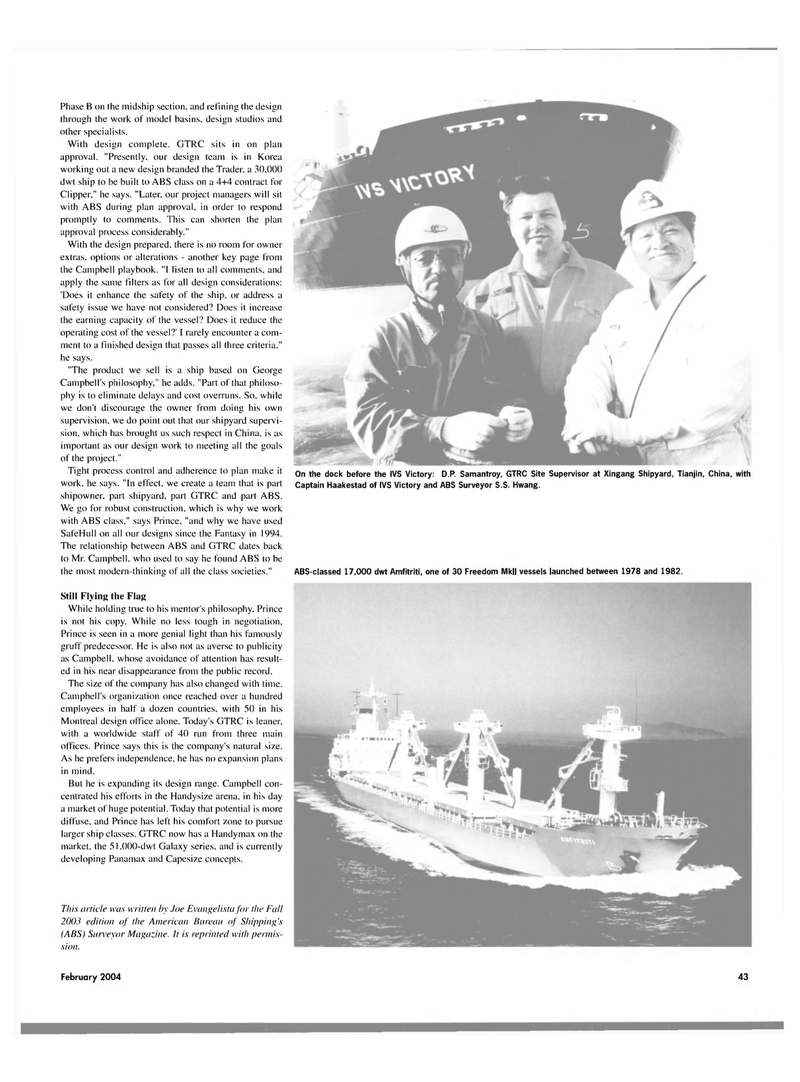
Page 48: of Maritime Reporter Magazine (February 2004)
The Tanker Yearbook: ATB Edition
Read this page in Pdf, Flash or Html5 edition of February 2004 Maritime Reporter Magazine
Phase B on the midship section, and refining the design through the work of model basins, design studios and other specialists.
With design complete. GTRC sits in on plan approval. "Presently, our design team is in Korea working out a new design branded the Trader, a 30,000 dwt ship to be built to ABS class on a 4+4 contract for
Clipper." he says. "Later, our project managers will sit with ABS during plan approval, in order to respond promptly to comments. This can shorten the plan approval process considerably."
With the design prepared, there is no room for owner extras, options or alterations - another key page from the Campbell playbook. "1 listen to all comments, and apply the same filters as for all design considerations: 'Does it enhance the safety of the ship, or address a safety issue we have not considered? Does it increase the earning capacity of the vessel? Does it reduce the operating cost of the vessel?' I rarely encounter a com- ment to a finished design that passes all three criteria." he says. "The product we sell is a ship based on George
Campbell's philosophy," he adds. "Part of that philoso- phy is to eliminate delays and cost overruns. So, while we don't discourage the owner from doing his own supervision, we do point out that our shipyard supervi- sion, which has brought us such respect in China, is as important as our design work to meeting all the goals of the project."
Tight process control and adherence to plan make it work, he says. "In effect, we create a team that is part shipowner, part shipyard, part GTRC and part ABS.
We go for robust construction, which is why we work with ABS class," says Prince, "and why we have used
SafeHull on all our designs since the Fantasy in 1994.
The relationship between ABS and GTRC dates back to Mr. Campbell, who used to say he found ABS to be the most modern-thinking of all the class societies."
Still Flying the Flag
While holding true to his mentor's philosophy, Prince is not his copy. While no less tough in negotiation,
Prince is seen in a more genial light than his famously gruff predecessor. He is also not as averse to publicity as Campbell, whose avoidance of attention has result- ed in his near disappearance from the public record.
The size of the company has also changed with time.
Campbell's organization once reached over a hundred employees in half a dozen countries, with 50 in his
Montreal design office alone. Today's GTRC is leaner, with a worldwide staff of 40 run from three main offices. Prince says this is the company's natural size.
As he prefers independence, he has no expansion plans in mind.
But he is expanding its design range. Campbell con- centrated his efforts in the Handysize arena, in his day a market of huge potential. Today that potential is more diffuse, and Prince has left his comfort zone to pursue larger ship classes. GTRC now has a Handymax on the market, the 51,000-dwt Galaxy series, and is currently developing Panamax and Capesize concepts.
This article was written by Joe Evangelista for the Fall 2003 edition of the American Bureau of Shipping's (ABS) Surveyor Magazine. It is reprinted with permis- sion.
On the dock before the IVS Victory: D.P. Samantroy, GTRC Site Supervisor at Xingang Shipyard, Tianjin, China, with
Captain Haakestad of IVS Victory and ABS Surveyor S.S. Hwang.
ABS-classed 17,000 dwt Amfitriti, one of 30 Freedom Mkll vessels launched between 1978 and 1982.
February 2004 43

 47
47

 49
49
